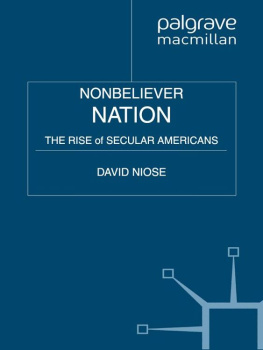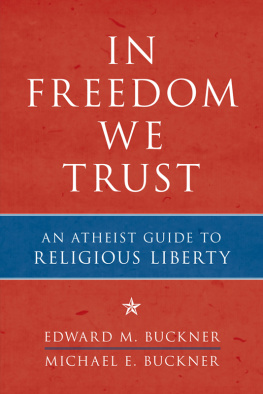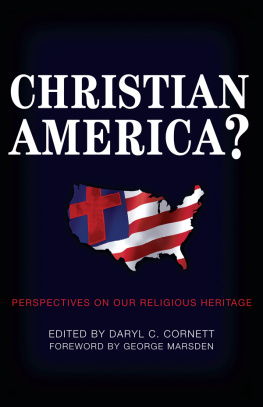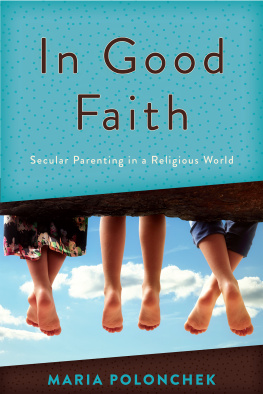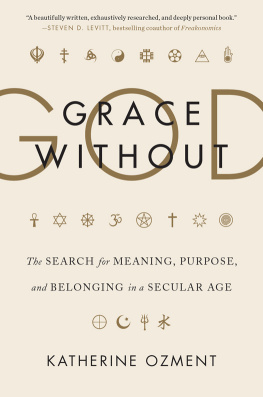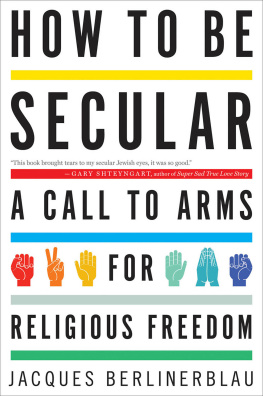ADDITIONAL PRAISE FOR NONBELIEVER NATION
Covering a wide range of territory in a reasonably condensed space, attorney Niose (president, American Humanist Assoc.) looks at the culture wars from the perspective of secular America. While confronting numerous commonly held misconceptions by believers about secularism (e.g., the religious Right implying that religious faith is part of patriotism), Niose admirably refrains from antireligious hostility, striving for equality rather than proving the superiority of his perspective.... This is a calm, informative, and positive portrait of the rapidly growing secular segment of the American population. Highly recommended for politically oriented readers of all religious persuasions.
Library Journal
This excellent book is simultaneously disturbing and reassuring. David Niose lays bare the whole dismal history of how the Religious Right hijacked America and betrayed the secular intentions of the Founding Fathers. Fortunately, as he also documents, decent Americans are now fighting back, and the book ends on an uplifting note of hope.
Richard Dawkins, author of The God Delusion
David Niose is a talented writer with keen insights into contemporary secularism. As a key leader in the secular movement, Niose is uniquely situated to help Americans understand this fast-growing phenomenon.
Rob Boston, author of Why the Religious Right is Wrong About Separation of Church and State
Dave Niose is a highly valued and respected leader in the secular movement.
Wendy Kaminer, author of Free for All and Im Dysfunctional, Youre Dysfunctional
Dave Niose writes clearly and concisely and advocates effectively for the secular tradition. I expect Secular Americans who read this book will feel more motivated to seek the visibility and respect they so richly deserve.
Herb Silverman, president of the Secular Coalition for America
NONBELIEVER
NATION
THE RISE of SECULAR AMERICANS
DAVID NIOSE


NONBELIEVER NATION
Copyright David Niose, 2012.
All rights reserved.
First published in 2012 by PALGRAVE MACMILLAN in the United Statesa division of St. Martins Press LLC, 175 Fifth Avenue, New York, NY 10010.
Where this book is distributed in the UK, Europe and the rest of the world, this is by Palgrave Macmillan, a division of Macmillan Publishers Limited, registered in England, company number 785998, of Houndmills, Basingstoke, Hampshire RG21 6XS.
Palgrave Macmillan is the global academic imprint of the above companies and has companies and representatives throughout the world.
Palgrave and Macmillan are registered trademarks in the United States, the United Kingdom, Europe and other countries.
ISBN 978-0-230-33895-1
Some names have been changed in this work to protect privacy.
Small segments of this work first appeared in David Nioses blog, Our Humanity Naturally: The Myth of Militant Atheism, Mommy, Dont We Love America? and On Being Post-Theological
Library of Congress Cataloging-in-Publication Data
Niose, David.
Nonbeliever nation : the rise of secular Americans / David Niose.
pages cm
Includes index.
ISBN 978-0-230-33895-1 (hardback)
1. SecularismUnited States. 2. Religion and politicsUnited States. 3. Culture conflictUnited States. I. Title.
BL2760.N5632012
211.60973dc23
2011049323
A catalogue record of the book is available from the British Library.
Design by Letra Libre, Inc.
First edition: July 2012
10 9 8 7 6 5 4 3 2 1
Printed in the United States of America.
For Katy, whos given me much in which to believe.
CONTENTS
INTRODUCTION
THE DECLINE OF THE AMERICAN DIALOGUE
A CENTURY AGO, IN THE HISTORIC PRESIDENTIAL CAMPAIGN OF 1912, American voters saw a rare contest of four relevant candidates: the unpopular Republican incumbent, William Howard Taft; Democratic challenger Woodrow Wilson; former president Theodore Roosevelt, running on the Progressive (or Bull Moose) ticket; and Socialist Party candidate Eugene Debs. The abundance of candidates was just one of many remarkable aspects of the campaign, for few American presidential elections have seen such dramatic twists and intrigue.
Roosevelt, who just four years earlier had selected Taft as his successor, now returned to presidential politics to challenge the incumbent for the Republican nomination, polarizing the party between two men who were a study in contrasts. Energetic and full of gusto, having embarked on an African safari after leaving the presidency in 1909, Roosevelt campaigned with zeal and progressive rhetoric. He was popular among Republican voters and won the vast majority of state primaries, including even Tafts home state of Ohio. Taft, meanwhile, the heaviest man to ever occupy the White House, conveyed none of Roosevelts vigor and charisma nor his populist spirit. He carried only one primary state.
In 1912, however, primary elections were not as critical as they are today. Only about a dozen states had presidential primaries back then, so most of the delegates needed for the nomination were instead selected by party insiders. Unlike today, when the national convention is usually just a coronation ceremony where the only suspense might be the selection of the nominees running mate, a century ago the conventions were frequently an arena for heavyweight politicking and backroom deals, where multiple ballots would often be needed to finally decide the ticket. Thus, having been beaten badly in the primaries, Taft was nevertheless able to use his influence with party regulars at the GOP convention in Chicago to secure the nomination. This was much to the chagrin of Roosevelt who, not a gracious loser, alleged improprieties and stormed out of the hall with his delegates, subsequently forming the Progressive Party with himself at the top of the ticket.
The scene was nearly as wild at the Democratic convention in Baltimore, where the party took a grueling 46 ballots before finally selecting its nominee. House Speaker Champ Clark appeared to be the early favorite, but his ties to the corrupt Tammany Hall political machine eventually led party stalwart William Jennings Bryanwho himself had been the Democratic presidential nominee three times previously (losing the general election each time) to throw his support to Wilson, thereby leading others to do the same. Wilson, the erudite, moralistic former president of Princeton University and governor of New Jersey, was perceived as a moderate reformer with integrity.
Adding a unique new angle to the campaign would be Eugene Debs, the passionate socialist who argued that he was the only true progressive in the race, accusing Roosevelt of demagoguery and calling all three of his opponents pawns of large business interests. Debs received almost a million votes in the general election, an impressive 6 percent of the total, representing an all-time high-water mark for any Socialist Party candidate.
The raucous nomination battles of 1912 were just a prelude to the general campaign. A few weeks before the November election, Roosevelt was shot in the chest by a deranged saloonkeeper before giving a speech in Milwaukee. Consistent with his tough-guy image, Roosevelt denied immediate medical care and went on to deliver a lengthy speech despite the bullet lodged inside him. The Taft campaign, meanwhile, would suffer a blow of its own when Tafts running mate, the sitting vice president James Sherman, died of natural causes just a week before the election, a fatality that was ominously foretelling of the Taft administrations own impending demise.
Next page
